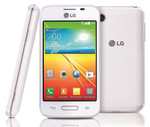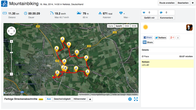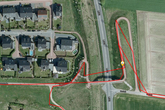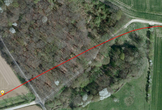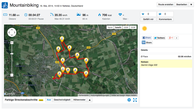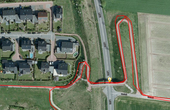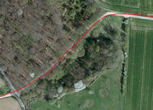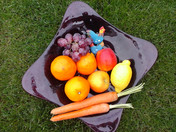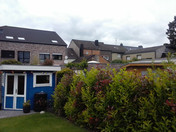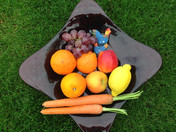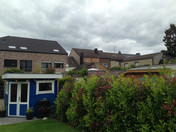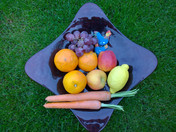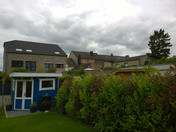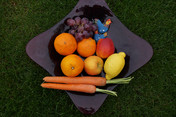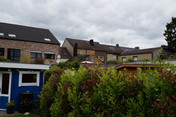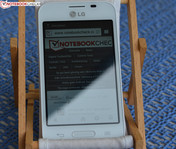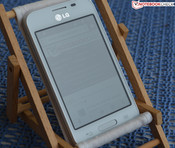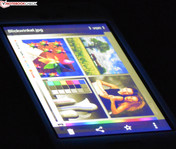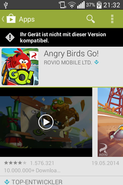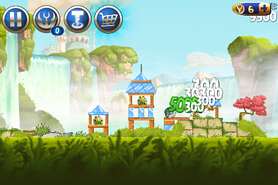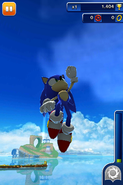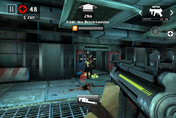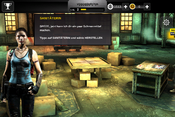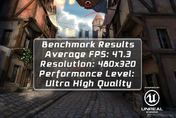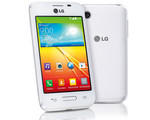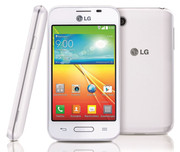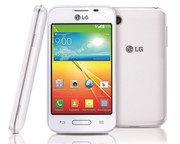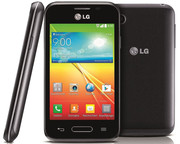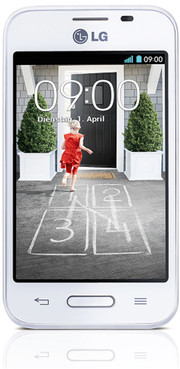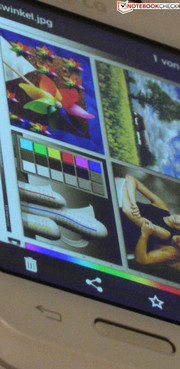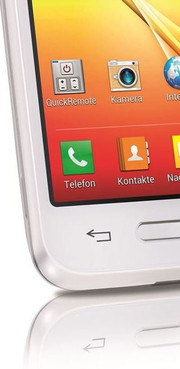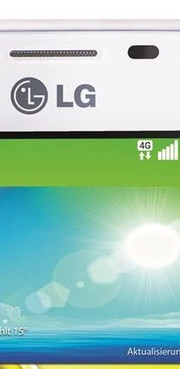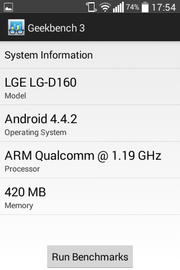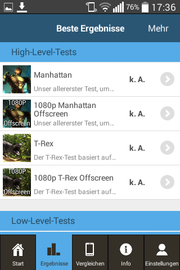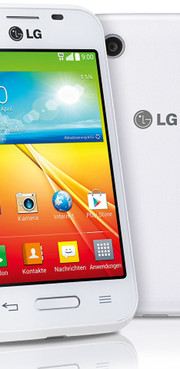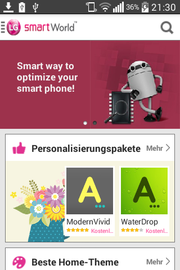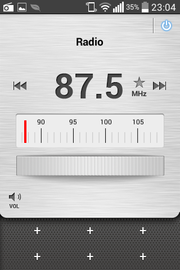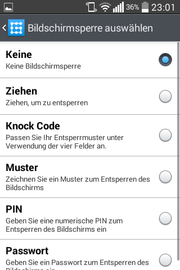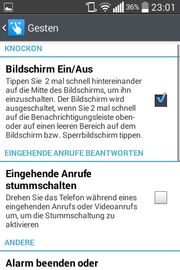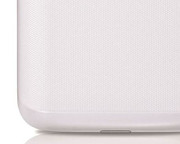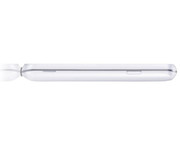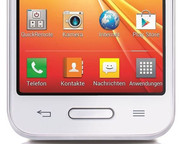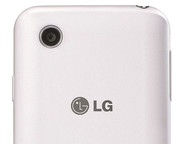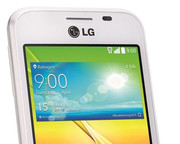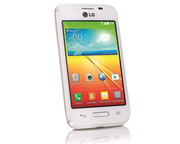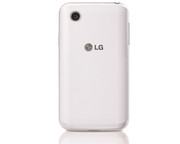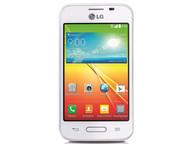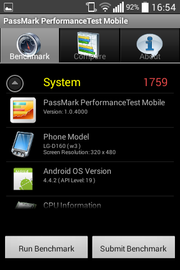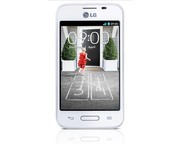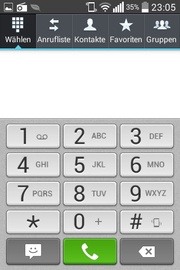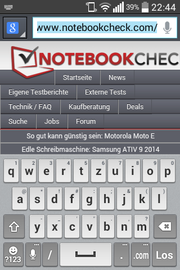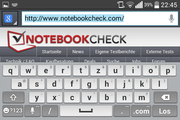LG L40 Smartphone Review
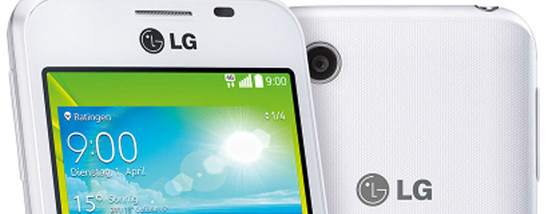
For the original German review, see here.
LG primarily wants to cater to smartphone-market newcomers with the L-product line that is now in its third generation. However, LG's L40 is not only interesting for this group with a price of 89 Euros (~$120; RRP) and the latest Android 4.2.2 KitKat operating system. LG furnishes the L40 with a 3.5-inch IPS screen, and it is powered by Qualcomm's Snapdragon 200 MSM8210 dual-core SoC that clocks with 1.2 GHz beside a tight 512 MB RAM and small 4 GB flash memory. The latter can be expanded by up to 64 GB via a MicroSD card. UMTS is just as available as Wi-Fi b/g/n. Although LTE is not part of the package, the battery can be removed.
LG has many rivals in this price range with its L40. Among them we find slightly more expensive contenders, such as Motorola's Moto E, Huawei's Ascend Y530, Acer's Liquid Z3, and Nokia's X.
Case
Although LG's L40 will not win any design awards, it is attractive. The textured back and rigid display cover have a nice feel. The small size and the enveloping rounded edges are also a delight for the hands. The stiffness test was surprising - the casing barely yielded even under stronger pressure. The gaps are exemplary equally spaced for this price range. LG's L40 is very compact with a weight of only 113 grams (~4 oz), and smaller dimensions than Apple's iPhone 4s with the same screen size. A nice detail: the removable back cover reveals a removable battery - not to be taken for granted in this category.
Connectivity
The L40 does not show any surprises here: a micro-USB 2.0, 3.5 mm jack, and slots for standard-sized SIM and MicroSD cards is all that is found. The volume rocker and power button have been placed in an ergonomically logical position, and feature a clear pressure point.
Communication & GPS
LG furnishes its L40 with the Wi-Fi standard 802.11 b/g/n and Bluetooth 4.0 for short-range data transfer. Wi-Fi reception was satisfactory, but it could be a bit higher. The signal remained in the lower third in the test with a distance of approximately 10 meters (~33 feet) to the router and through several walls. The review sample features GSM quad-band (850/900/1800/1900 MHz) and UMTS dual-band (900/2100 MHz) for on the move. The latter's possible bandwidth is 14.4 Mbps in download and 5.76 Mbps in upload. The reception is acceptable here.
The A-GPS module's reception strength is good, tested with the GPS Test app. Our navigation test exhibited shortcomings in difficult surroundings, such as driving through the woods, or in tight curves, but localization is overall quite satisfactory.
Telephony & Speech Quality
The phone app's functionality corresponds with the good Android standard, but its appearance has also been modified with the Easy UI.
The review sample's speech and audio quality are a bit disappointing. Voices sounded muffled and tinny. Furthermore, the volume of the LG L40 fluctuates even if the person on the other end is silent. Unfortunately, there is no status LED to indicate missed calls either.
Cameras & Multimedia
LG installs only one camera module on the device's back. It has a sufficiently high resolution of 3 megapixels (2048x1535 pixels). Videos can be recorded with a maximum of 800x480 pixels. The lens' shortcomings become obvious when compared with the contenders. Pictures are usually overexposed, and lack natural colors as well as sharpness. Nevertheless, the given quality is sufficient for the odd snapshot.
Accessories
LG offers the familiar, limited standard and adds the battery, a quick start guide, and a charging adapter with data cable for the smartphone.
Warranty
LG includes a warranty period of 24 months on the L40; the battery is only covered for 6 months.
Input Devices & Controls
The multi-touch screen is quite accurate up to its edges and implements inputs almost immediately. The gliding capabilities are good. Like LG's G2, the L40 also has the feature dubbed Knock-On that activates the device easily from standby. The alternative security code Knock-Code from the L90 has also found its way into the review sample. The small screen benefits from the navigation bar with a physical home button incorporated in the bezel.
Although the keyboard only has small keys due to the small screen, they can be used quite accurately. In addition to buttons for .com/.net/.ort (there is unfortunately no .de), a smiley button is available. Numbers can always be entered by pressing the uppermost row for a longer time. The layout can be switched to various languages with the press of a button.
Display
The L40's screen operates with the IPS technology, and has a rather low resolution of 480x320 pixels. Nevertheless, text can usually be read well, although it is not extremely sharp. We measured an average screen brightness of approximately 380 cd/m². Thus, it is in the midfield in the category comparison, and surpasses both Huawei's Ascend Y530 and Acer's Liquid Z3 Duo. However, it does not achieve the brightness of devices like Nokia's X or even Motorola's Moto E. Although the illumination of 91% is good, the contenders are at minimum on par if not better.
| |||||||||||||||||||||||||
Brightness Distribution: 91 %
Center on Battery: 396 cd/m²
Contrast: 776:1 (Black: 0.51 cd/m²)
ΔE Color 6.01 | 0.5-29.43 Ø5
ΔE Greyscale 5.45 | 0.57-98 Ø5.3
Gamma: 2.29
With a black level of 0.51 cd/m² and contrast of 776:1, LG's L40 scores very well in the category comparison, and is only defeated by Acer's Liquid Z3 Duo. The reproduction of dark content is subjectively appealing.
The analysis using the X-Rite i1Pro 2 colorimeter in conjunction with the CalMAN software reveals that the displayed red hues are a bit too dark. In return, blue hues are too strong. Mixed colors achieve an average DeltaE of 6.01, which is within an acceptable limit. A slight green-yellowish cast is visible here.
The screen's color temperature rate of 6954 K comes close to the ideal value, and the grayscale's DeltaE is a satisfactory 5.45. Nevertheless, a green-bluish discoloration is evident in the grayscale reproduction. This color cast already starts in quite dark gray hues. These deficiencies are subjectively not as obvious as thought.
Owing to the good maximum brightness of 396 cd/m², outdoor use is principally possible, but suffers under the missing automatic brightness sensor. Besides that, the intensely reflective screen clearly complicates the outdoor readability.
LG's L40 has very stable viewing angles owing to the underlying IPS technology. Content first dims slightly in extreme viewing angles, but colors remain stable. Just as typical for the In-Plane-Switching technology is the glowing of dark images, but that is not distracting in routine use.
Performance
LG's L40 sports Qualcomm's Snapdragon 200 MSM8210 dual-core SoC that clocks at 1.2 GHz, and incorporates an Adreno 302 GPU alongside low 512 MB of RAM. This SoC is a member of the lower entry level, and thus we do not expect a magnificent application performance.
Our benchmark course shows where this hardware is located in the category comparison. The surprise: All contenders perform below par, and are usually clearly inferior to our review sample in virtually all benchmarks. Particularly Nokia's X and Acer's Liquid Z3 Duo lag far behind with their weaker hardware, as can be seen impressively in the 3DMark Ice Storm benchmark. In return, Huawei's Ascend Y530 and Motorola's Moto E are almost on par with LG's L40. This is especially obvious in Geekbench 3. The AndroBench 3 storage test certifies that the review sample's internal storage performance is good in a direct comparison.
| AnTuTu v4 - Total Score (sort by value) | |
| LG L40 | |
| Nokia X | |
| Motorola Moto E 1. Gen 2014 | |
| Huawei Ascend Y530 | |
| Acer Liquid Z3 Duo | |
| Geekbench 3 | |
| 32 Bit Multi-Core Score (sort by value) | |
| LG L40 | |
| Motorola Moto E 1. Gen 2014 | |
| Huawei Ascend Y530 | |
| Acer Liquid Z3 Duo | |
| 32 Bit Single-Core Score (sort by value) | |
| LG L40 | |
| Motorola Moto E 1. Gen 2014 | |
| Huawei Ascend Y530 | |
| Acer Liquid Z3 Duo | |
| AndEBench | |
| Java (sort by value) | |
| LG L40 | |
| Nokia X | |
| Motorola Moto E 1. Gen 2014 | |
| Acer Liquid Z3 Duo | |
| Native (sort by value) | |
| LG L40 | |
| Nokia X | |
| Motorola Moto E 1. Gen 2014 | |
| Acer Liquid Z3 Duo | |
| AndroBench 3-5 | |
| Random Write 4KB (sort by value) | |
| LG L40 | |
| Motorola Moto E 1. Gen 2014 | |
| Huawei Ascend Y530 | |
| Acer Liquid Z3 Duo | |
| Random Read 4KB (sort by value) | |
| LG L40 | |
| Motorola Moto E 1. Gen 2014 | |
| Huawei Ascend Y530 | |
| Acer Liquid Z3 Duo | |
| Sequential Write 256KB (sort by value) | |
| LG L40 | |
| Motorola Moto E 1. Gen 2014 | |
| Huawei Ascend Y530 | |
| Acer Liquid Z3 Duo | |
| Sequential Read 256KB (sort by value) | |
| LG L40 | |
| Motorola Moto E 1. Gen 2014 | |
| Huawei Ascend Y530 | |
| Acer Liquid Z3 Duo | |
This positive trend continues in the browser-based benchmarks, but with restrictions. Although the performance - likely owing to Android 4.4.2 - is clearly higher than that of the contenders, not all benchmarks could be performed smoothly. For example, both Peacekeeper and Octane v2 repeatedly crashed, and did not provide any scores - in both the Android browser as well as Google Chrome. Sunspider 1.0 behaved in the same manner in the Android browser, but finished in Google Chrome. Only Kraken 1.1 and WebXPRT 2013 completed the run without crashing. We did not experience any problems with browsing in routine use.
| Sunspider - 1.0 Total Score (sort by value) | |
| LG L40 | |
| Nokia X | |
| Huawei Ascend Y530 | |
| Acer Liquid Z3 Duo | |
| Mozilla Kraken 1.1 - Total (sort by value) | |
| LG L40 | |
| Motorola Moto E 1. Gen 2014 | |
| Huawei Ascend Y530 | |
| Acer Liquid Z3 Duo | |
| WebXPRT 2013 | |
| Offline Notes (sort by value) | |
| LG L40 | |
| Acer Liquid Z3 Duo | |
| Stocks Dashboard (sort by value) | |
| LG L40 | |
| Acer Liquid Z3 Duo | |
| Face Detection (sort by value) | |
| LG L40 | |
| Acer Liquid Z3 Duo | |
| Photo Effects (sort by value) | |
| LG L40 | |
| Acer Liquid Z3 Duo | |
| Overall (sort by value) | |
| LG L40 | |
| Acer Liquid Z3 Duo | |
* ... smaller is better
Finally, the Epic Citadel graphics benchmark shows appealing performance compared with the contenders. LG's L40 particularly outshines its rivals Motorola Moto E and Huawei Ascend Y530 in the Ultra-High Quality setting.
| Epic Citadel | |
| Ultra High Quality (sort by value) | |
| LG L40 | |
| Motorola Moto E 1. Gen 2014 | |
| Huawei Ascend Y530 | |
| High Quality (sort by value) | |
| LG L40 | |
| Motorola Moto E 1. Gen 2014 | |
| Huawei Ascend Y530 | |
| High Performance (sort by value) | |
| LG L40 | |
| Motorola Moto E 1. Gen 2014 | |
| Huawei Ascend Y530 | |
Games
LG's L40 features the SoC-integrated Qualcomm Adreno 302 graphics card that uses the rather tight RAM of 512 MB alongside the Qualcomm Snapdragon 200 MSM8210. This array is not graphically strong, but should, nevertheless, be suitable for the odd gaming session.
We tested this using a few 3D games to exemplify this. While Angry Birds Go! is too demanding, games like Angry Birds Star Wars 2 or Sonic Dash run smoothly. Even the Zombie shoot-up Dead Trigger 2 can be played without problems - though only in low details.
The touchscreen, position sensor and accelerometer work reliably. However, gaming fun is limited due to the small screen.
Emissions
Temperature
The measured surface temperatures on LG's L40 are virtually exemplary. The phone barely heats up while idling, and a maximum average of 31.7 °C (89 °F) is reached. The temperatures also only reach an average of 30.5 to 32.2 °C (86.9 to 90 °F) during full load.
(+) The maximum temperature on the upper side is 34.7 °C / 94 F, compared to the average of 35 °C / 95 F, ranging from 21.9 to 56 °C for the class Smartphone.
(+) The bottom heats up to a maximum of 31.8 °C / 89 F, compared to the average of 33.8 °C / 93 F
(+) In idle usage, the average temperature for the upper side is 31.7 °C / 89 F, compared to the device average of 32.7 °C / 91 F.
Speakers
LG's L40 uses the receiver on the front as the mono speaker. Although this is beneficial for the sound quality, the little speaker struggles with treble-heavy playback. Both the mid range and bass step into the background. The hands-free feature works impeccably and is quite low in noise.
Energy Management
Power Consumption
The power consumption of LG's L40 is very moderate. The review sample's idle consumption of 0.3 to 1.0 Watts is lower than all rivals. The L40's power hunger climbed to 1.2 Watts during load, which is considerably less than that of its contenders. Agreeable: We ascertained a typical standby consumption of 0.1 Watts. Acer's Liquid Z3 Duo, Huawei's Ascend Y530, Motorola's Moto E, and Nokia's X are again on par with that. The low consumption rates give hope for good battery runtimes.
| Off / Standby | |
| Idle | |
| Load |
|
Battery Runtime
The removable battery provides the L40 with 5.85 Wh or 1540 mAh. Though that is less than Huawei's Ascend Y530 (1750 mAh, 6.5 Wh) or Motorola's Moto E (1980 mAh), our review sample surpasses all contenders in the Wi-Fi test, performed using a brightness of 150 cd/m². LG's L40 lasts considerably longer than its rivals with a runtime of over 14 hours. Only the Motorola's Moto E comes close to that. Our review sample shut down after 3:41 hours in the full load test, using the Stability Test app and maximum brightness. This is a bit less than Motorola's Moto E and Acer's Liquid Z3 Duo. Overall, a very good performance.
Verdict
LG presents a compact smartphone with an entry-level SoC for a low price of only 89 Euros (~$120; RRP) dubbed L40. The buyer gets a bright, high-contrast, and viewing angle stable IPS screen that, however, struggles with a low resolution and an intensely reflective screen surface.
Owing to the latest Android 4.4.2 KitKat operating system, the L40 is up-to-date. Furthermore, newcomers on the smartphone market will find an intuitive and usually smooth usage owing to the Easy UI. The application performance is clearly enough for routine tasks, such as Internet browsing, messaging or sending mails, and even allows an occasional game although the small screen will likely be a limiting factor. The extremely small internal storage of 4 GB is annoying in routine use. Only about 1.5 GB net is available for apps. At least the storage can be expanded via a MicroSD card.
The camera units and speaker are not compelling. Unfortunately, the speech quality is also poor. That is twice as unfortunate because the battery is very long lasting, and even removable. Besides that, LG's L40 supplies software features from the upper range, such as Knock-Code or Knock-On, and the optional guest access allows parents, for example, to control their children's smartphone use.
Newcomers looking for an uncomplicated smartphone, or buyers simply wanting an affordable second device might find it in LG's L40. Users who put value on a larger, sharper screen, and a somewhat better configuration for a similarly low price should take a closer look at LG's L70. An in-depth review will be available in a few days time.


 Deutsch
Deutsch English
English Español
Español Français
Français Italiano
Italiano Nederlands
Nederlands Polski
Polski Português
Português Русский
Русский Türkçe
Türkçe Svenska
Svenska Chinese
Chinese Magyar
Magyar